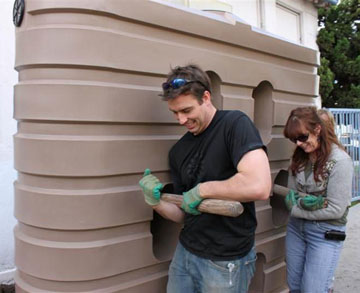This is a section of a modular water wall.
I did a quick search and others are also thinking along these lines and some of the walls are very decorative. The idea of free or cheap drums is admirable but they are not large enough nor are they aesthetic.

It's time to think outside the box. What about large reservoirs of water under our houses or hidden within our walls which would also be used to moderate temperature with it's thermo-mass.
I used to live in a very old house in downtown Tucson. The walls were built of adobe and they were nearly 3 feet thick. The hot Tucson summers were quite bearable due to the thermo-mass of these walls even though I had no air conditioning.
If we were to build houses like this our energy and water consumption would both drop. A stucco finish would make the walls look like any other house except for thick walls, and the comfort would be amazing. This water could be collected during the rainy season and used later in the hot dry summer months to grow food and ensure a beautiful cooling landscape.
.
A family of five uses about 1 acre foot (about 325,000 gallons) or (1225 m3) of water a year. So saving water from your roof top may only make a small difference, but small differences add up. Right now it costs about $1000 to process that much water from waste water or to build a new reservoir.
Desalination has been done in other parts of the world and California is going to build a desalination plant in San Diego capable of 50 million gallons (189000 m3) a day. But the cost is probably going to be twice the cost we are used to. There are also concerns that the plant will kill fish, but efforts are being incorporated that should solve this problem.
In total fifteen desalination projects using reverse osmosis are proposed along the coast from Los Angeles to San Francisco Bay. In the past many other desalination plants have been closed due to the high cost of operation. The plant will use an enormous amount of energy -- about 38 megawatts, enough to power 28,500 homes.
The efficiency works out to be about 3 kWh for 1 m3or 88 gallons / kWh fresh water. Sounds like a lot of water, but the reality is this will only provide about 7 percent of the total water needs of San Diego County.
Another problem I see is that this is going to be privately owned. I would prefer to see communities own their own water source.


No comments:
Post a Comment